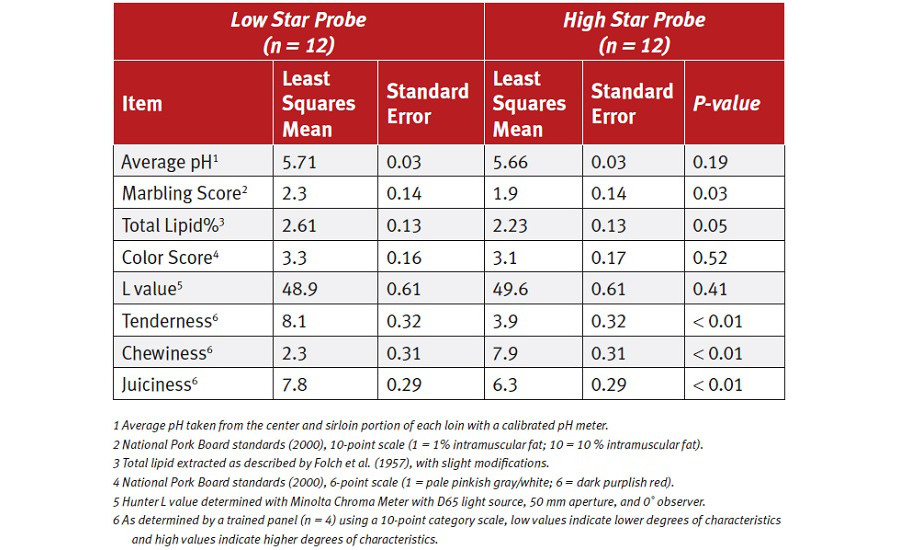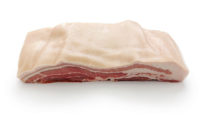Inconsistency in pork tenderness is an issue consumers, chefs and purveyors are challenged with every day. Tenderness is imperative to meat quality, but methods to measure tenderness in large-scale processing facilities have not yet been established. There is value in defining the features of fresh pork loins that contribute to variation in sensory quality. It is understood that pH, color and marbling can influence pork quality. It also is known pork quality can vary even when these traditionally defined quality determinants are held constant. The objectives of this study were to determine the explanation for variation in fresh pork tenderness when pH, color and marbling are not different.
Fresh pork loins (n = 159) were collected one day postmortem from carcasses of commercial Duroc-sired pigs. After aging loins approximately 13 days, chops (1 inch thick) were fabricated and evaluated for purge, cook loss, ultimate pH, visual color and marbling, Hunter L, a, b values, sensory, star probe (kg) and total lipid. Loins that had extreme star probe measurements were selected if in range for ultimate pH (5.54-5.86), visual marbling score (1.0-3.0), and total lipid (1.61-3.37 percent). These ranges were selected because previous research shows ultimate pH and lipid content can influence measured tenderness in fresh pork. A trained sensory panel (n = 4) was used to evaluate tenderness, chewiness, juiciness and flavor of chops. Instrumental tenderness was measured with an Instron fitted with a star probe attachment (Figure 1). This measures the peak force necessary to compress and puncture a chop with a programmed cycle of an 80 percent compression. Star probe analysis has a strong negative correlation to sensory tenderness and a strong positive correlation with sensory chewiness. Selected samples were grouped into either a low star probe (LSP, n = 12) or high star probe (HSP, n = 12) group. The average star probe value for the LSP group was 4.95±0.25 kg and the average star probe value of the HSP group was 7.75±0.74 kg.
SDS-PAGE and Western blots were used to identify degradation differences in the proteins troponin-T, desmin and filamin between LSP and HSP samples. SDS-PAGE gels were evaluated for titin degradation differences.
Results showed LSP and HSP samples exhibited similar ultimate pH and color scores. Marbling and lipid were statistically greater in the LSP group, but the difference was subtle. Table 1 also summarizes notable advantages in sensory tenderness, chewiness and juiciness observed in the LSP group compared with the HSP group. Therefore, this sample group provides the opportunity to understand why tenderness can vary a great deal when pH, color and marbling do not vary widely. Biochemical evaluation of these aged pork loins showed the LSP samples exhibited 100 percent more degradation products of troponin-T, 255 percent more degradation products of desmin, and 33 percent less intact filamin than the HSP samples, which likely influenced why LSP chops were evaluated more tender from star probe and sensory analysis. Evaluation of titin SDS-PAGE gels showed presence of intact titin in some HSP samples (a novel observation because titin is typically degraded very early postmortem), which may contribute to the toughness measured in HSP chops.
Results from this study demonstrate even when ultimate pH, total lipid and color are similar in samples, there can still be extreme differences in measured tenderness. The notable degradation differences in troponin-T, desmin, filamin, and titin show proteolysis greatly affects tenderness. The results demonstrate that we can search for biomarkers linked to protein degradation to characterize fresh pork to give more consistent eating experiences. It is also important to continue to determine the explanation for the observed differences in postmortem degradation of structural proteins that can affect fresh pork tenderness. NP






